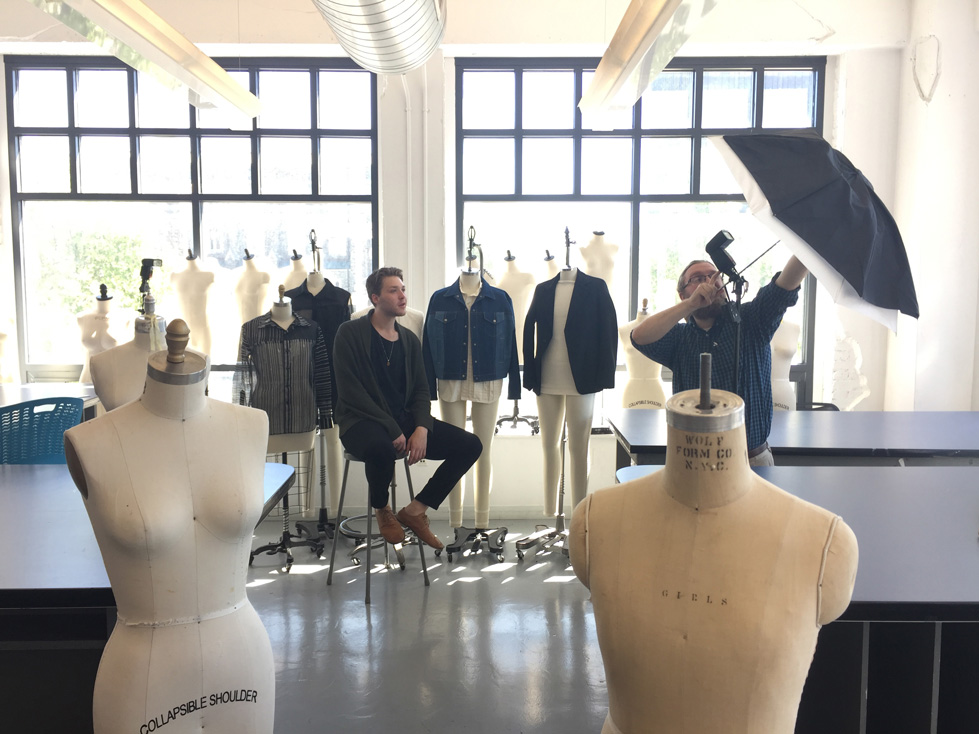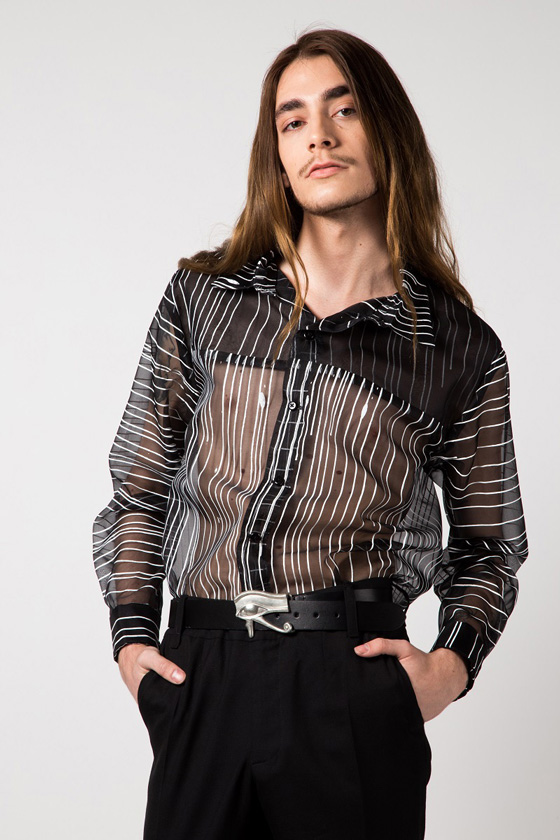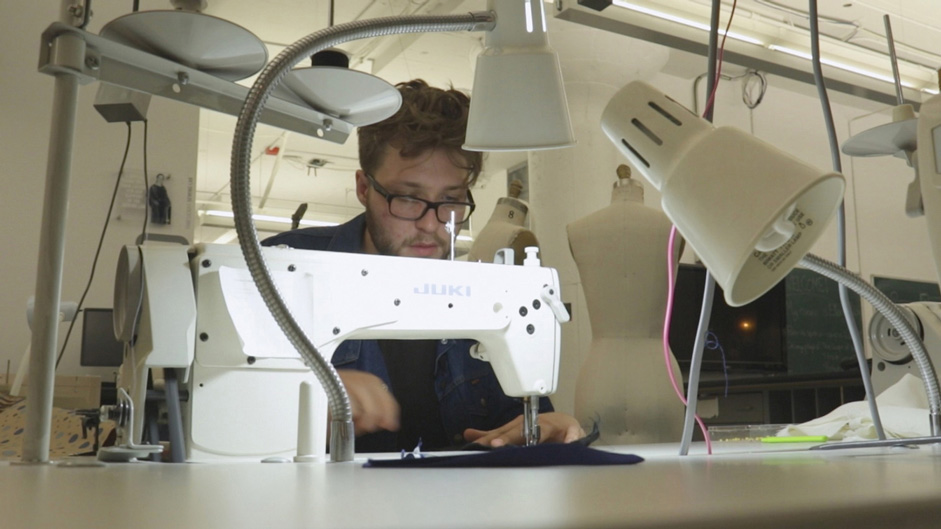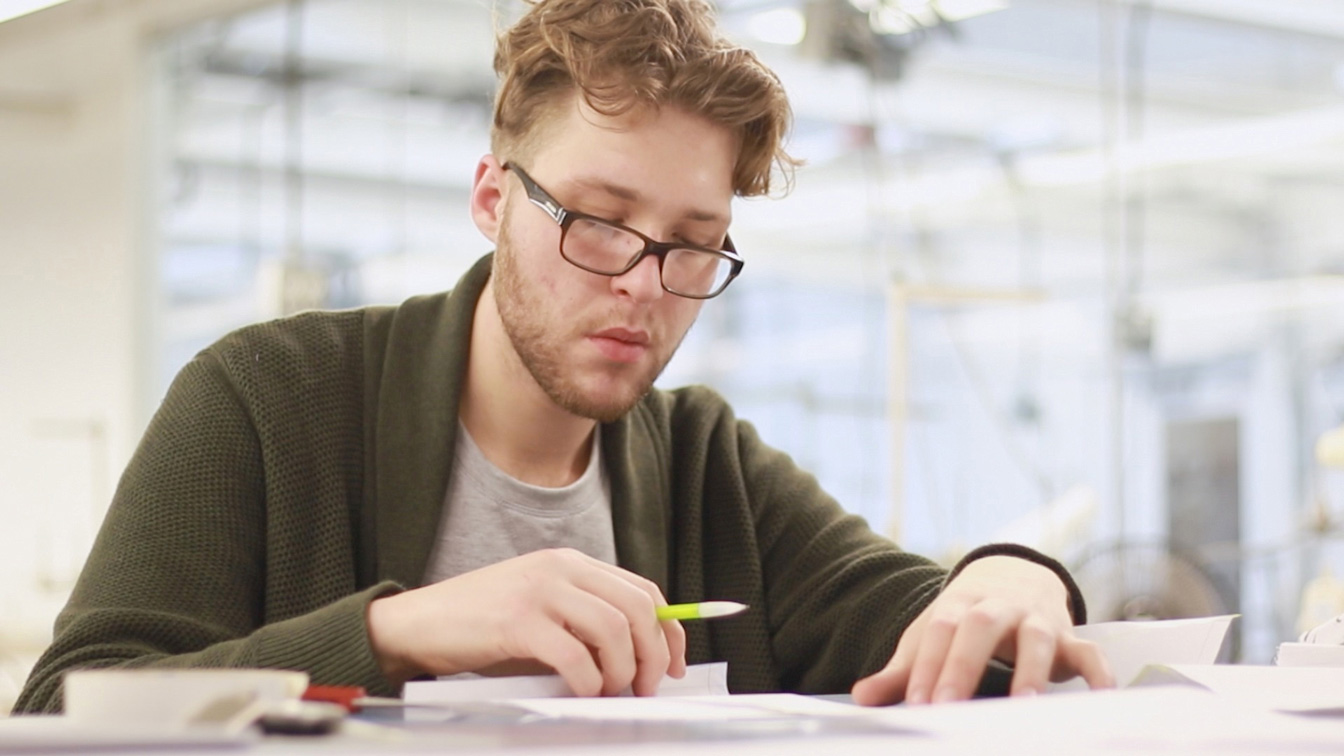
CCAD Stories: Isaac Cohn makes (and finds) history in fashion
Influencers | What he's listening to | Isaac Cohn's time-tested sensibilities | It's his business

Denim, Italian suiting, bamboo knitwear, and custom pleated, translucent organza are among the materials — traditional and not-so-traditional — comprising new menswear designs from Isaac Cohn (Fashion Design, 2017), which will hit the runway at the Senior Fashion Show this Friday, May 12.
Cohn, who will graduate from Columbus College of Art & Design the following day, described his designs as ones for a customer who is “educated and has a disposable income. He’s an urban fellow, and he likes to be a little forward in his fashion, but he’s still very traditional and sophisticated. He has a playful personality and he likes to express that through the way he dresses.
“He’s very confident in the way he represents himself. … There’s a touch of elegance to it. He walks into a room, and someone’s going to look at him.”
Although he’s only in his early 20s, Cohn’s sophisticated take on fashion has a history that goes back decades. The Urbana, Ohio, native started going to estate sales with his great-grandmother Pauline Vulgamore when he was a teen. He would pluck items from the free pile to add to his personal collection, and eventually, those finds became merchandise in his own small business.
“My grandmother’s neighbor and I set up a flea market booth with this stuff I had collected from these free piles (and occasionally my mom would let me buy stuff here and there). … Then I just never stopped,” Cohn recalled.
“I was going to these estate sales, buying wardrobes and I was seeing, firsthand, these decades of fashion.”
And at the same time, Cohn was being reared in a community and family that valued thrift and innovation.
“At my house, we didn’t really buy new things,” he said. “If you needed something, you would try to find the most useful thing.”

Vulgamore, who lived to be 100, made her home in a former schoolhouse. “It was 100 years’ worth of life in one house. … I was fascinated by the history behind belongings and where things came from, and the way that’s part of who we are,” Cohn said.
“All of my grandmothers sewed,” he continued. “My mom’s mother, they were poor, so she made all of her clothes, and my dad’s grandmother cross-stitched. I remember she taught me how to sew on a paper towel on the front porch.”
Another defining moment in Cohn’s fashion evolution happened when he learned of an auction in a “three-story mansion” in Troy, Ohio. The home’s previous occupant had come from several generations of multimillionaires and had purchased “three of everything” — and had held onto it all, Cohn recalled. After buying a few fur coats, Cohn was offered the opportunity to bid on a larger lot, sight unseen. His $150 got him decades of one woman’s fashion — and a new perspective on the longevity and significance of great designs.
“It was everything from the mid-50s until 2009. So I got to see another person’s entire evolution through fashion firsthand. … All of her cocktail dresses, her eveningwear — it was really cool,” he said.

An Isaac Cohen design
Thanks to this stock and other vintage discoveries, Cohn’s flea market booth eventually grew into Dorcey’s, a brick-and-mortar store in Urbana.
Still, as a high school junior, he found himself wanting more. A chance encounter with a CCAD student prompted Cohn to look the college up online. “And I was like, ’Mom, I want to go here.’ … I toured it in January, on the first day back in classes just to show my parents. I didn’t know what I was getting myself into, but I wanted to do this.” he said.
Leaving Dorcey’s and heading off to school “was a total life switch. I had to give up one life for another,” he said. But, “the school has done a lot for me.”
Cohn began as an Interior Design major, but within a week, switched to Fashion Design. His work in retail had given him a solid, if informal, training in interior design and commercial merchandising, he said, and he decided that if he was going to pay for college, he wanted to learn something totally new.
And that he has.
“I learned mostly about me — what’s good for me, what’s not good for me, and the direction I want to take things in,” he said. “I have been given a world of technical skills, and it’s changed the way I look at things. It’s just unbelievable. I didn’t know the world that existed until I came here.”

Ever since he was a precocious teen raiding the “free” pile at tag sales, Isaac Cohn (Fashion Design, 2017) has found passion in vintage fashion and antiques.
When he was 15 years old, Cohn opened, with his grandmother’s neighbor, a flea market booth where he resold his finds. Later, the summer between his junior and senior years of high school, he opened Dorcey’s, a brick-and-mortar vintage shop, with interior designer Kristie Herlong.
The search for quality vintage in his past gave him a sharp eye for quality design, which led him to pursue a career in fashion design.
Now he’s at Columbus College of Art & Design, making distinctively modern clothing designs — albeit designs that are intended to stand the test of time and reflect the quality of materials and the craftsmanship of vintage clothing.
Although he departed Dorcey’s when he started school at Columbus College of Art & Design, Cohn has continued to keep an eye out for classic quality designs. Below, he shares some of his favorite antique finds of late.

"This is a Victorian-era walnut wardrobe said to have come out of a mansion in Springfield, Ohio. I bought this at an estate sale last year in my hometown of Urbana, Ohio. I’ve always loved this period of furniture for its grandeur and the fantasy-like experience you have while using it as a utilitarian object."

"Here is a turn-of-the-century washstand I found in a dumpster on my way to class the other day. I liked this because it shows a few different furniture styles all married into one made of multiple types of wood."

"This 18” Roseville bushberry floor vase that I found at a local secondhand shop last year was made by the Roseville pottery Co. in Zanesville, Ohio, in the early 1940s. It’s the largest of this particular pattern’s series — and this particular art pottery was one of the first things that I really fell in love with and started to collect."
Isaac Cohn's Top 4 Creative Influencers
Kristie Herlong, interior designer and co-owner with Isaac Cohn of Dorsey's | Instagram | Facebook
Dan Fawcett, antiques dealer Cohn shadowed for a number of years while in high school
Pauline Vulgamore, Cohn's great-grandmother. "She was always creating out of necessity. Through her, I learned the value of respecting your materials at hand and the importance of making things with the quality to withstand time."
CCAD community, "They're always leaving me inspired. I'm proud to a part of a group of such talented individuals."

Some teens get a job bagging groceries, babysitting, working fast-food, or lifeguarding the neighborhood pool.
Isaac Cohn (Fashion Design, 2017) took a different route.
He wasn’t yet 16 when he opened up a flea market booth with his grandmother’s neighbor. And by the summer between his junior and senior years of high school, he’d grown his business, expanding it into Dorcey’s, a store in his native, Urbana, Ohio, selling vintage home decor and clothing items.
He’s since left Dorcey’s in the hands of co-founder Kristy Herlong — “It was a total life switch. I had to give up one life for another” — but his fashion designs, meant to stand the test of time, give a nod to longevity of the decades-old apparel and furniture that he worked with in his formative teen years. (A selection of his work can be seen this Friday, May 12, at the Senior Fashion Show.)
Below, Cohn talks about his experience as a young entrepreneur in the antiques resale world.


“The first sale I remember going to was at one of my great-grandmother’s friend’s house. … It was this cool ’60s ranch house, and each room was a bright vibrant color, and there was shag carpet on the floor. … There was this massive free pile, and I was 12, 13 years old picking stuff out of the free pile, and I just really enjoyed it. So we started going to a sales and picking stuff from the free pile and I had this little collection.”
“My grandmother’s neighbor and I set up a flea market booth with this stuff I’d collected from these free piles, so occasionally my mom would let me buy stuff here and there. … I got the booth when I was almost 16, and one of the first times I got to drive by myself was to take stuff there. That was a big deal for my dad. My parents just kind of let me run with it.”
“It started as a small first-floor thing (at the flea market), and then it went to the basement, it went to the second floor, and it just turned into this huge thing that I was part of, building a brand. … Kristy and I had become really close over that period of time, and we would go do (antique) shows together.”
“The summer between junior and senior year of high school, we opened up a shop (Dorcey’s). It was a brick-and-mortar store, and it was fun. … While all this was going on, I’m going to these estate sales, I’m buying wardrobes, I’m going through and I’m seeing, firsthand, decades of fashion.”

“The biggest influence was seeing this flyer on AuctionZip for an auction in Troy. … I got there, and it was the second sale. The first sale had about 250 fur coats; the second had about 100, so I bought five or 10. Then they came down and said, ’If there’s anyone interested in buying a large quantity of clothes, we’re just going to take bids. … I had no idea what I was about to buy, so I said $50, but a lady told me it had to be a higher bid. She gave me the number I needed to win, and I won it. So basically, she gave me this collection for $150. … I filled a 10’ x 20’ storage unit with this woman’s wardrobe. She had three of everything, and it was everything from the mid-50s until 2008. So I got to see an entire person’s evolution through fashion firsthand, and I was the only person who got to see that, all of her cocktail dresses, her eveningwear. It was really cool.”
“There was an older guy, Dan Fawcett, who was a very well-known antiques dealer where I’m from. … He’s the one who really taught me how to identify, like, in a room of 3,000 things, what the few actually good things are. So he taught me how to tell what’s good, and to spot good design through the mess. He took me under his wing and was a big influence.”
“When I was 16, 17, 18, standing in a room where everybody’s 30 and above, they were like, ’Who’s this kid over here bidding against me? What the hell is he doing?’ I definitely had to show dominance and let them know I’m here and I’m going to do this. It took a lot of perseverance, a lot of self-determination. … At one point I was going three antique shows a month, or about once a week.”
“(After coming to CCAD) I worked at Old World New Home (in Grove City) for three years. … I learned a lot about painting there — I painted a lot of furniture. I think that’s why I like surface (design) so much. … I love painting on furniture and surface application. I worked there freshman through junior year — and then thesis took over my life.”
“(Dorcey’s cofounder) Kristy Herlong was the one who really pushed me to go into fashion design. She’s a dreamer and very talented. She’s the one who instilled in me that there’s a bigger picture out there, and to go chase after that picture.”
Read more in our series CCAD Stories. Discover more about the CCAD Student Agency. Learn more about CCAD's Fashion Design program or apply here.
Post date
May 9, 2017